Several elements are needed to cut a fabric on the bias. It is important to define several terms to explain the work we do every day in our high quality production workshops.
The most important thing is to explain what a fabric is. You need to know the 6 elements that make up a fabric and give it its characteristics.
First of all, the weave corresponds to the way in which the warp and weft yarns are crossed. The fabric weight gives the precise number of grams per square metre of the piece of cloth in question. The warp yarn density indicates the number of threads per centimetre, following the warp. The weft yarns, also give the number of threads per centimetre, but following the weft. Finally, the thickness of the threads used in the warp and the weft, indicating the thread diameter, also gives important information about the quality of the fabric.

You often hear the term “lengthwise grain”. But what is the grain of a fabric? Lengthwise grain is simply the perpendicular crossing of the two threads:
- lengthways, you have the warp shown here in red
- crossways, you have the weft shown here in blue

To obtain a fabric on the bias, you have to start from the grain of the fabric, then go through two stages: rolling into a tube then cutting on the bias. At AJ Biais, we cut the fabric at a 45° angle to obtain a cylinder of fabric on the bias.




